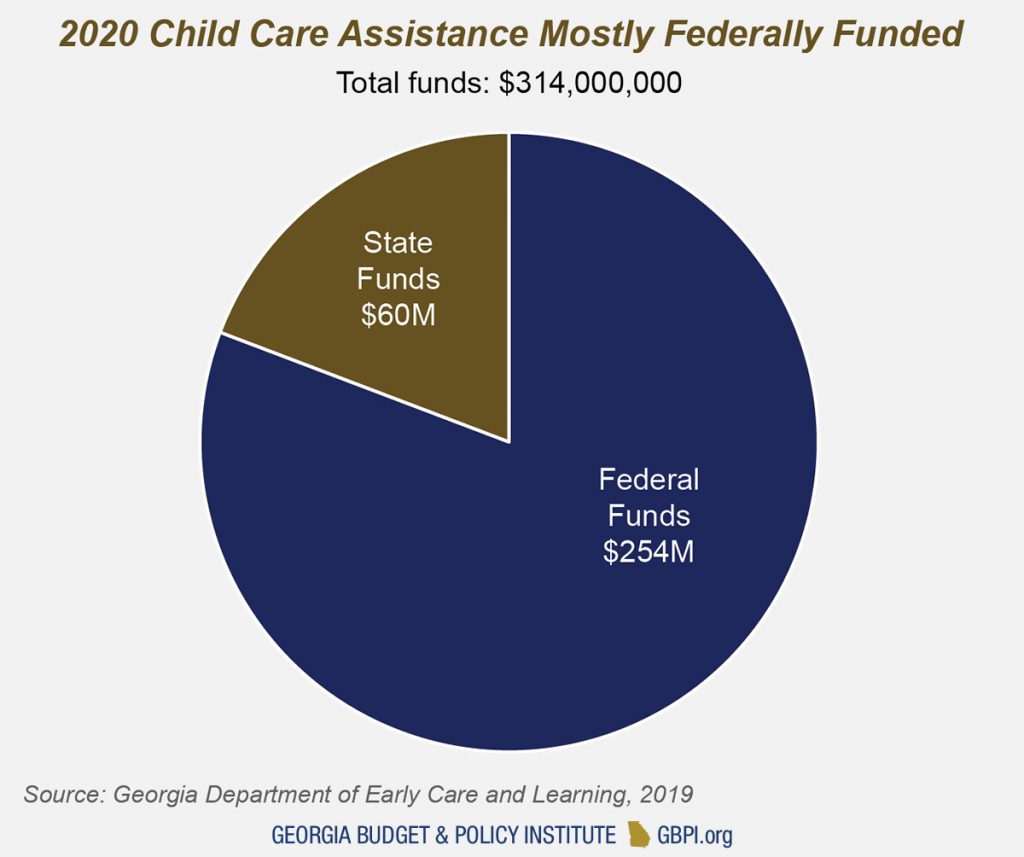You can download and share all the images and charts in the Human Services Primer by clicking here.
Georgia’s 2020 budget for the Department of Human Services is $830 million and includes new support to ensure the safety of Georgia’s most vulnerable children. The budget provides the agency with $36 million more than the prior year.
The spending plan continues payments for families caring for foster children. The agency plans to make significant improvement to its system this year to reduce both the number of youth in foster care and reports of child abuse.
Most state funding for the agency is for child welfare and foster care related services. The Division of Family and Children Services’ efforts to protect the welfare of children account for about 63 percent of the agency’s overall budget.
The state pays staffers to evaluate eligibility for federal low-income assistance programs, such as Medicaid, the Supplemental Nutrition Assistance Program and Temporary Assistance for Needy Families. Smaller yet vital programs such as vocational training for adults and elder protection services account for the remaining funds.
 Foster Care: New Funds Put Families First
Foster Care: New Funds Put Families First
Improving Georgia’s foster care system remains a priority for the Department of Human Services. The state’s 2018 and 2019 budgets helped ease expenses associated with caring for youth in foster care by raising the payment rates for foster families. The 2020 budget adds about $10 million more than the prior year to pay for new foster families, with an emphasis on placing foster care children with relatives.
The agency is also adapting to major reforms brought on by 2018’s federal Family First Prevention Services Act. The act’s goals are two-fold: to prevent children from entering foster care by using federal money to pay for support services that help children remain with family, and to increase the placement of children with relatives instead of group care facilities.
Georgia’s goal is to place 50 percent of foster youth with relatives. The current rate is 32 percent, up from 15 percent in 2013.
 New Child Welfare Funds Prioritize Prevention
New Child Welfare Funds Prioritize Prevention
The child welfare portion of the Human Services budget, $202 million, pays investigators who look into allegations of child abuse, abandonment and neglect. Growing resources in this branch of the agency also reflect the state’s compliance with the Family First Prevention Services Act.
The 2020 budget includes money to update the state’s online SHINES child welfare database. Database improvements aim to help the agency’s frontline caseworkers conduct timely investigations of child abuse, document cases and refer families to services. The goal is to allow the agency to intervene and provide family support to avoid referring a child to the foster care system. The plan is to provide at-risk families with increased access to mental health services, substance abuse counseling and parenting training.
Reports of child abuse nearly doubled in Georgia in recent years, to 127,000 in 2018 from 67,859 in 2012.
 Lack of Low-Income Support Creates Hardship
Lack of Low-Income Support Creates Hardship
Georgians in many pockets of the state still struggle with unemployment, jobs offering low wages and fewer hours than they are willing to work, or simply a scarcity of quality job opportunities.
The Department of Human Services 2020 budget includes $121 million to pay hundreds of state employees to administer federal safety net programs that provide basic support for people with little income until they get back on their feet.
The state’s level of support for low-income Georgians remains insufficient. Many counties still cope with high unemployment and job scarcity. These challenges could lead to greater demand for services that support low-income people and require the agency add additional case workers to administer benefits and help workers find jobs that pay enough to support a family.
 Child Care Assistance Need Far Exceeds, Outstrips Resources
Child Care Assistance Need Far Exceeds, Outstrips Resources
The Department of Early Care and Learning provides access to affordable child care for low-income working families. Parents who receive child care subsidies experience fewer work disruptions, stay employed longer and enjoy higher family earnings.
Georgia’s 2020 budget adds $500,000 to pay for new openings for children. The average annual cost of child care for an infant in Georgia was about $9,000 in 2018. Child care expenses can consume nearly half of a low-income family’s budget.
The state’s child care assistance program serves about 54,000 children per week, but it is likely more than 600,000 income- eligible children in low-income working families need it. More funding is needed to ensure all Georgia parents can afford high- quality child care.
Continue reading the 2020 Georgia Budget Primer
|
|
|
|
|
|














